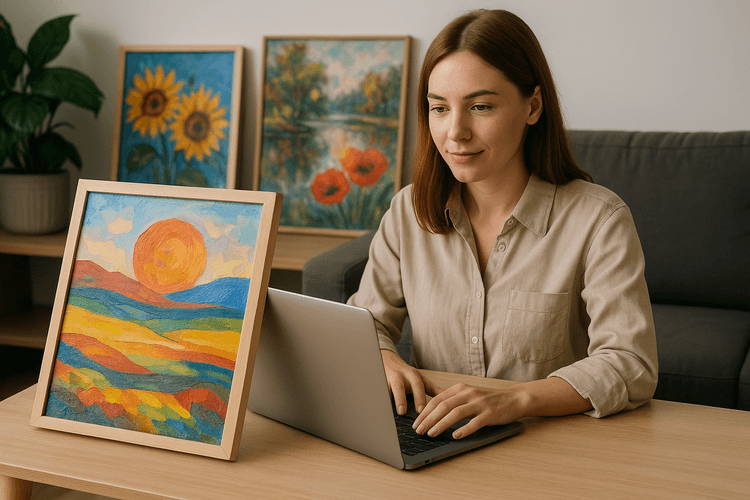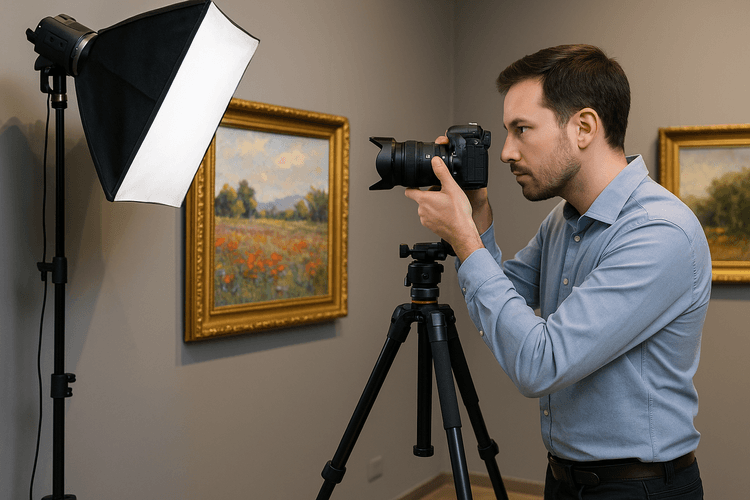
Selling paintings online is an exciting challenge for artists, collectors, and art galleries. There are many benefits to opening an online painting store: you can reach an international audience, reduce management costs compared to a physical gallery, and have more control over your own image.
However, the world of selling paintings online can be difficult to navigate. There are many platforms and services available, each with its own advantages and disadvantages. Moreover, there are many practical considerations to keep in mind when trying to create a successful store.
What to sell
Before opening an online painting store, it's important to decide what you want to sell. This may seem obvious, but there's a lot to consider in selecting the right products for your store.
Firstly, you need to decide whether you want to sell original artworks or prints. Original artworks generally have a higher value but also require greater initial investment. Prints can be more accessible to average customers but might require a larger volume of sales to generate the same profit as original works.
Secondly, one must choose the genre or style of paintings to sell. In this case, it's important to analyze your target audience and their interests. For example, if you wish to appeal to contemporary art collectors, you might focus on emerging artists who work in this field.
Creating an e-commerce website
Once you've decided what to sell, it's necessary to create a website to sell your paintings online. Choosing the right platform for your business is crucial: Framework360 is one of the leading complete digital marketing platforms that will help you create and manage your own e-commerce site with full autonomy and customization.
In general, a good e-commerce website should be easy to navigate, feature high-resolution images of the products, and provide detailed information about the artwork (such as size, materials used, and the history of the piece itself).
It's also important to invest in SEO to make your website easily discoverable by search engines. By using techniques such as optimizing keywords in page titles and product descriptions, you can increase the visibility of your online store.
Promoting your online art store
Once you have created your online art store, you need to promote it to reach the right audience. There are many online marketing strategies that can be used, including:
- Search engine advertising (like Google AdWords)
- Social media advertising (such as Facebook Ads and Instagram Ads)
- Email marketing
- Participating in online art fairs
Furthermore, it is important to engage with existing customers to create a loyal community. You might consider using a blog or a dedicated social account for your business to create interesting and engaging content.
Selling paintings online requires time and effort, but it can be extremely rewarding both artistically and financially. With the right combination of products, website design, and marketing strategies, you can create a successful store that attracts customers from all over the world.
How to choose the right paintings to sell online

Selling paintings online can be a profitable venture, but to do so successfully you need to offer potential customers high-quality products. Here are some tips on how to choose the right paintings for your online store.
1. Choose your style
Before you start looking for paintings to sell, think about your style and the audience you want to reach. Do you want to offer modern artwork or do you prefer classic pieces? Are you aiming at emerging artists or those who are already well-known?
Choosing a thematic vein or a style that you're passionate about can help you select the right paintings and stand out from the competition. For example, if you love contemporary art, modern art, you might specialize in that and look for works by emerging artists on the market.
2. Consider the quality of the artwork
The quality of the artwork is an important factor to consider when choosing the right paintings to sell online. Make sure that the product images are clear and detailed so that customers can see exactly what they are buying.
Also, evaluate the quality of the material used to create the painting: canvas, colors, frame. Investing in high-quality paintings will increase the value of your online store and customer trust.
3. Create a diverse offering
Offering a wide range of artworks can be an effective way to meet the needs of a broad customer base. Consider including paintings of different sizes, styles, and artistic techniques to create a diverse offering.
In addition, you might consider adding custom options such as having the canvas framed or printed on different supports like wallpaper or t-shirts.
4. Competitive pricing
Competitive pricing is a key factor in attracting customers to your online store. Research the prices of other online sellers to get an idea of what you should be offering. Additionally, try to offer periodic promotions and discounts to encourage purchases.
5. Marketing and promotion
Once you have selected the right paintings to sell online, it's important to let potential customers know they exist. Use all the tools at your disposal to promote your store: social media, blogs, newsletters, online advertising.
Furthermore, Framework360 offers advanced digital marketing tools that can help you reach your ideal audience accurately and effectively.
- Registration at Framework360: https://www.framework360.com/try-free/
- How to open an e-commerce site with Framework360: https://www.framework360.com/how-to-make-an-ecommerce-website/
Preparing paintings for online sale

Selling paintings online may seem like a straightforward task, but it actually requires a lot of care and attention in preparing the products. Here are some tips on how to prepare paintings for online sale:
Choosing the right frame
The frame is an important element of the painting and can make a difference in product presentation. Choosing the right frame will depend on the type of painting and the style you want to convey. For instance, if the painting has a vintage feel, pairing it with a dark wood or gilded frame might be perfect.
Photographing paintings at their best
Photos are the first thing that customers see when looking for a painting online, so it's crucial to photograph them as well as possible. Make sure to use good natural or artificial lighting, choose the right angle, and clearly show every detail of the painting. Additionally, images should be high quality and sharp to avoid looking blurry or pixelated.
Accurately describe the paintings
An accurate product description helps to provide important information to customers and create realistic expectations. The description should include details about the material used for the painting, the dimensions of the piece, the technique employed, and the author. Moreover, if there is a story or meaning behind the painting, share it in the description to create an emotional connection with the customer.
Set a competitive price
Price is one of the key factors in a customer's purchase decision. When setting the price, it is important to consider the value of the product, production costs, and shipping expenses. Additionally, keeping an eye on the competition can help establish a competitive price that is neither too high nor too low compared to the market.
- Choose the right frame;
- Photograph the paintings at their best;
- Accurately describe the paintings;
- Set a competitive price.
Always remember that careful preparation of your paintings is crucial for a successful online sale. By following these tips, you can present your products in an appealing way and increase the chances of making a sale.
Taking professional photos of paintings

The photos of your paintings are a fundamental element for online sales. Indeed, a quality image can make the difference between a sale and just a visit to your site.
Here are some tips for taking professional photos of your paintings:
Lighting
Make sure to use good lighting. Natural light is always the best option, so try to photograph your paintings during the day near a window or outdoors. If you need to take pictures indoors, ensure you have enough light sources such as lamps or spotlights.
Background
The background should be clean and uniform to highlight your painting. Use a neutral backdrop like a white sheet or an empty wall.
Framing
We recommend taking at least two pictures of your painting: one in a horizontal position and one vertical. This way, potential clients will have an accurate idea of the size of the artwork.
Additionally, make sure to frame the entire painting without cutting it off and keep the camera straight to avoid distortions in the final image.
Resolution
The resolution of your camera (or smartphone) should be high to prevent blurry or low-quality images. We recommend taking photos with a minimum resolution of 1024 x 768 pixels.
Editing
After taking your pictures, you can use editing software like Photoshop or Gimp to enhance their quality. For example, you can adjust brightness and contrast, crop the image, and correct colors.
- Ensure that your photos are sharp and clear
- Use a clean and uniform background
- Fully frame the painting without cutting it off
- Take at least two photos in both horizontal and vertical positions
- Your camera's resolution should be high
- Edit your photos to enhance their quality
By following these simple tips, you will have professional photos of your paintings that will surely attract the attention of potential customers on your e-commerce site!
How to write effective descriptions for your paintings

Descriptions are one of the most important factors in selling your paintings online. A good description should be detailed, engaging, and informative. Here are some tips on how to write an effective description for your paintings:
Research your audience
Before you start writing, it's important to understand your audience. Who are you trying to sell your paintings to? What are their needs and interests? What motivates them to purchase a piece of art?
Gather information about your audience through surveys, market analysis or simply by observing your current customer base. This will help you to create descriptions that resonate with your audience and invite them to purchase.
Be specific
In the description of your painting, you need to provide specific information about the size, material, technique used, and other important details. Do not assume that the customer already knows these things - provide all the necessary information to enable them to make an informed purchasing decision.
Include also information about your artistic background and creative goals. This can help build a connection with the customer and demonstrate the value of your work.
Use engaging language
The description of your painting should not be dull or technical. Use engaging language that invites the customer to imagine the artwork in their home or office. Use descriptive adjectives such as "vibrant", "intense", or "mysterious"."
Tell a story through your description - explain what inspired your painting, what emotion you want to convey, and what your creative goals are.
Include seo keywords
Finally, make sure to include SEO keywords in the description of your painting. These words help search engines find your artwork and improve the visibility of your site.
- Use specific keywords related to your artistic work and the techniques used.
- Avoid stuffing the description with too many keywords - this can appear spammy and harm your online reputation.
- Keep your descriptions original - avoid copying and pasting from other websites.
Writing an effective description for your paintings takes time and effort, but it's worth it to increase your online sales. Use these tips to create engaging descriptions that resonate with your audience and communicate the value of your artistic work.
How much to charge for your paintings and how to set the right price

Selling a piece of art has always been a challenge: on one hand, you want to value the work behind the masterpiece created, on the other hand, you need to consider the market value and competition.
To determine the right price for your paintings, there are several factors to pay attention to:
- Materials used: if you've used expensive materials, such as high-quality canvas or brand-name paints, this should be taken into account in the final price evaluation.
- Technique employed: some techniques require more time and effort than others. For instance, painting with watercolor demands a lot of patience and precision compared to painting with oil on canvas.
- Creation time: how long did it take you to create the artwork? If you spent months painting every detail, this should be reflected in the final price.
- Artist's Experience: If you're an emerging artist without much experience behind you, you'll likely have to sell your paintings at lower prices compared to famous artists who have already built a reputation in the art world.
- Demand: Generally, the price of a work of art also depends on its market demand. If you've created something very original that appeals to the audience, you can afford to slightly increase the price compared to other similar works.
In addition, to set the right price, you should conduct a market research to understand how much other artists are selling their paintings similar to yours.
Remember that setting the right price is important for your reputation as an artist and for attracting potential buyers. Moreover, if you sell your works online, you must consider the commissions that the e-commerce platform charges on each sale.
Practical example:
Suppose you have created an oil painting on canvas measuring 50x70 cm. It took you about two weeks to complete it and you used expensive, high-quality materials.
To set the right price, you might consider the following:
- Materials used: €50
- Technique employed: €150
- Creation time: €200
- Artist's experience: €100 (being an emerging artist)
- Demand: +€50 (since the work is very original and popular)
- E-commerce platform fees: -€40
In this case, the final price of your painting would be €510.
Remember that setting the right price takes time and research. Don't be afraid to experiment with prices, but be careful not to sell your works at prices too low or too high compared to their actual value.
Promoting your paintings online: social media, blogs, and newsletters

In addition to creating an ecommerce site for selling your paintings, it's important to effectively promote them on digital channels. Here are some strategies you can use to get the word out about your your paintings to a wide and interested audience.
Social media
Social media is a fundamental tool for promoting your paintings. Each platform has its own audience, so you will need to choose the ones that are most suitable for your market niche. For example, if you create minimalist or modern paintings, you might focus on Instagram, while if you produce more classical works, you could opt for Facebook or Pinterest.
Once you have chosen the right social platforms, make sure to have a business profile consistent with your artistic image and start posting photos of your paintings with detailed and engaging descriptions. Don't forget to use appropriate hashtags to increase the visibility of your posts.
Blog
Creating a blog on your ecommerce site can be an excellent strategy for attracting organic traffic to your products. Publish interesting articles about the art world, share your creative experiences, or discuss the creative process behind your paintings. Include images of your work and link to the product sales pages where they're available.
In this way, you can generate interest and engagement around your artistic activity and develop a community of enthusiasts for your work.
Newsletter
Creating a newsletter is an excellent strategy to keep your clients informed about new paintings, special offers, or events you will be attending. Make sure the newsletter is well-designed and consistent with your brand's image. Include images of your paintings, detailed descriptions, and direct links to related products.
Remember to send out your newsletters regularly but without being too intrusive. Try to create interesting and useful content for your target audience in order to increase interest and loyalty among your customers.
- Use the right social media channels for your type of art;
- Create a blog on your e-commerce site;
- Stay in touch with your customers through well-designed newsletters.
Create a personal website to sell your paintings online

To sell your paintings online, there are several platforms available on the market. However, if you want to have total control over your sales activity, creating a personal website is the ideal option.
With Framework360, you can create a customized website in just a few simple steps. First, register on Framework360 and access your personal environment.
After creating your account and exploring the features offered by the platform, install the specific plugin for e-commerce from those available. You can then customize the design of your website via the navigation menu on the left.
Once you have set up your website, you can start uploading your paintings in the dedicated section. Adding items for sale is easy thanks to the dedicated section present on the main screen.
- Click on the "Add product" button
Furthermore, to enhance customer experience and increase loyalty, we recommend using the functionality of campaigns with automations.
For example, you can create a newsletter campaign to regularly send subscribers the latest updates on your paintings. With the scheduling option, you can also set up automatic operations based on user actions on the site.
In conclusion, creating a personal website is the best way to sell your paintings online. With Framework360, you will have all the necessary tools to build a professional and personalized digital store.
Choosing the right shipping service for your needs

After setting up your e-commerce site Framework360, it is important to choose a shipping service that fits your needs. Selecting the right courier can have a significant impact on sales and customer satisfaction.
What to consider when choosing a courier?
- Cost: The price of shipping is obviously an important factor to consider. Make sure the prices are competitive compared to other options and that there are no hidden costs.
- Delivery times: Consider how quickly packages are delivered by the courier and whether they offer expedited shipping options for those customers who need the item urgently.
- Additional services: Some couriers offer additional services such as insurance on goods or the ability to track the package in real-time. Evaluate whether these services are important for you and your customers.
- Coverage area: Check if the courier serves all the areas where you want to sell your products. If you plan to sell internationally, also verify their global coverage.
Examples of couriers
Here are some examples of couriers that might be worth considering:
- Bartolini: Offers solutions for national and international shipments, with competitive rates and additional services such as insurance on goods.
- TNT: Known for its fast delivery times, TNT also offers additional services like real-time parcel tracking.
- DHL: DHL is one of the world's leading global logistics operators and provides a wide range of shipping services nationally and internationally.
Always remember to be careful in choosing the right courier for your business and your needs. Choosing a good courier can help increase sales and improve customer satisfaction, while choosing a bad courier can lead to negative reviews and a decrease in customer trust in your online store.
Now that you have created your e-commerce site for selling paintings, it's important to effectively promote it to reach the right audience and increase sales. Here are some strategies you might adopt:
- SEO: Optimize your website for search engines so that it appears among the top results when someone searches for keywords related to your products.
- Online Advertising: Use platforms such as Google Ads or social media advertising to create targeted ads for your reference audience.
- Email Marketing: Regularly send newsletters to your customers and subscribers to keep attention high on your activity and inform them about new arrivals and special offers.
- Social Media: Create profiles on major social networks (Facebook, Instagram, Pinterest, etc.) and share images of your paintings along with detailed descriptions and links to your website.
- Collaborations: Consider the possibility of collaborating with bloggers, influencers, or other artists to increase the visibility of your business.
Remember that promoting your business will take time and consistent effort, but if you are determined and follow these strategies consistently and in the long term, you will definitely see results.
In any case, do not forget that the quality of your paintings and your artistic style remain the fundamental aspect to attract and retain customers. Once a painting is sold, make sure to provide excellent service to your clients in order to receive positive feedback and increase your online reputation.
With the right marketing strategies and a great passion for art, you can create a successful online painting sales business and steadily grow your enterprise.
You can do it too, you just need a lot of commitment and an excellent marketing and sales platform.
Free trial for 30 days. No credit card required.







